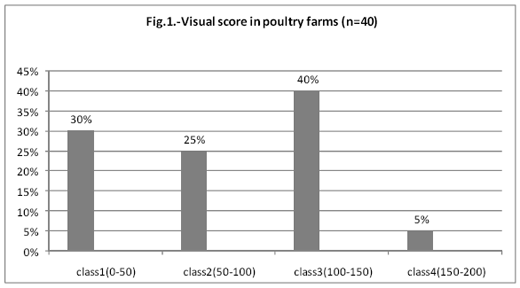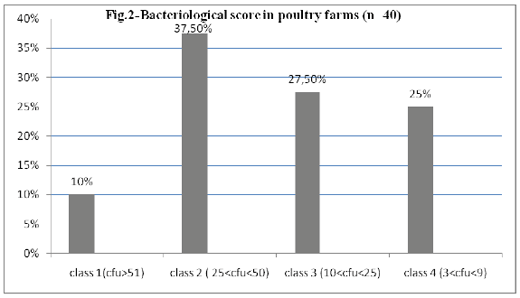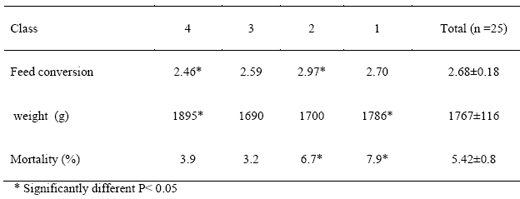Biosecurity Practices in the East Algerian Poultry Farms
Published: October 27, 2008
By: N. Alloui, F. Ibrir, A. Ayachi and M.N. Alloui - ESPA Laboratory, Poultry Sciences Service, University of Batna, Algeria (Presented at the Ist Mediterranean Summit of WPSA, Greece)
Biosecurity is a practice designed to prevent the spread of diseases in poultry farms. It is accomplished by maintaining the facility in such a way that there is minimal traffic of biological organisms (viruses, bacteria, rodents, vermin etc.) across its borders (Gernat, 2000).
The objective of this work was to determine the level of adoption within the Algerian poultry farms (broiler chickens, laying hens) of a range of standard biosecurity practices (isolation, traffic control, sanitation, vaccination…). Quantitative and qualitative evaluation of the biosecurity in the poultry houses has been analysed using a method developed by the French Food Safety Agency (AFSSA) (Drouin, 1988; Drouin and Toux; 2000).
A factorial analysis of the collected data has permitted to determine four classes of poultry farms.
Class 1 and 2 regroup 55% of the examined poultry farms, and were represented by farms that are very badly maintained by breeders who do not respect the elementary hygiene measures (precarious buildings, impure water, non respect of the sanitary vacuum, bad disinfection, presence of contamination vectors, lack of incineration of the chickens corpses…). The two classes were given visual scores between 0 - 100 points and CFU ( faecal streptococci) > 25.
Class 3 and 4 regroup 45% of the poultry farms, and demonstrated that the number of faecal streptococci colonies /25 cm2 is the lowest (3 < CFU < 9) and (10 < CFU < 25) respectively. In these farms, <CFUthe sanitary teams apply very rigorous barriers of security and decontamination. Visual scores attributed to these two classes ranged between 100-200 points.
The decline in the production performances (mortality, feed conversion, and laying rate) especially observed in the poultry farms (class 1, 2) was because of the failing of the sanitary barriers during the production period.
MATERIALS AND METHODS
The investigation was realised in 40 poultry farms located in the East of Algeria, during the period between 2002-2006. The passage into buildings was made before the implementation of the breeding flock. For each breeding, a technical index card was distributed to collect information (population density, vaccination, body weight, feed consumption, feed conversion, and rate of laying, mortality, decontamination, and the period of sanitary vacuum…).
Of the 40 poultry houses involved in this inquiry, 25 were broiler chickens- houses and 15 were layers houses, with breeding capacities ranging from 5000-10.000 and 10.000 -30.000, respectively.
Quantitative and qualitative evaluation of the biosecurity in the poultry houses has been analysed using a method developed by the French Food Safety Agency (AFSSA) (Drouin and Toux, 2000), which consists in making two operations:
1-“hygienogramme”: method based on the visual control of poultry house after decontamination. A score between 0 – 200 points is attributed to the poultry houses according to the quality of the decontamination and traffic control in the poultry houses.
2-bacteriological control: 16 contact limps of 25 cm2 (faecal streptococci) are used for each poultry house (640 bacteriological samples for 40 buildings). Sampling was made after the decontamination (pest control, rat extermination, cleaning and disinfection) of buildings, including the following places: doors, cages, and carpets of droppings, ventilation circuits, feeding dishes, watering places, floors and walls.
After an incubation of 36 hours, the number of colonies was counted and the results were compared with the norms established by the AFSSA - CIDEF (Cable and Fargeas, 2000).
All the gathered data were analysed by a factorial analysis of multiple correspondences (AFCM), in order to determine different classes of biosecurity (hygienic status, traffic control, sanitary barriers) in the examined poultry farms. For each type of biosecurity, production performances were determined by analysis of variance.
RESULTS AND DISCUSSION
Factorial analysis of multiple correspondences associated to a hierarchical ascending classification has permitted to determine four classes of poultry farms.
Visual control of decontamination and traffic control are weak for most breeding (fig.1). From 40 poultry farms, only two class (class 4 and 3) have a satisfactory biosecurity procedures, score (150 - 200) and (100-150), respectively. These two classes account for 45% of the poultry farms.
In the other poultry farms (55%), biosecurity procedures were considered insufficient and the score is lower than 100 points (class 1 and 2). The qualification of the staff in methods of decontamination plays a very important role in the success of the fight against vectors and contaminants.
Bacteriological control (fig.2) revealed the following results in the different classes:
Class 4 regroups, unfortunately, 25% poultry farms and demonstrates that the number of faecal streptococci colonies is the lowest (3 < CFU < 9). In these farms, the sanitary team apply very rigorous <CFUsanitary barriers.
Class 3 constituted partially by 27.5% poultry farms. Bacteriological score of the decontamination can be considered as acceptable (10 < CFU < 25) In this group, breeders are very aware of the problem of <CFUhygiene measures, and they strictly apply the advice and orders of their veterinarian (medical prevention, rigorous decontamination, under floor space, access to the strictly regulated poultry houses).
Class 2 (25 < CFU < 50) and class 1 (CFU > 51) regroup breedings that are very badly maintained by breeders who do not respect the elementary hygiene measures (absence of pediluvium, precarious buildings, non respect of the sanitary vacuum , auto medication, badly made disinfection, presence of contamination vectors, corpses of animals on the site). These two classes represent 47.5 % of poultry farms.
The bad management of the cleaning, disinfection operation and the sanitary barriers failings during the breeding period could be the causes (Drouin, 1988; Rokicki and Kolbuszewski, 1996; Rose and al.2000).
The breeders that respect the biosecurity measures obtain best performances in broiler farms (table 1). Mortality rates are generally low in breeding where hygienic status ranged in the class 3 and 4. Weight gain and feed conversion are slightly low in badly maintained breeding. These results confirm studies made by the other authors (Drouin 1988, Cardinal et al., 2001).
Laying hens performances (table 2), notably the laying rate and the egg mass are slightly more favorable in poultry farms where hygiene and traffic control are well applied (class 4). The analysis of the variance allowed to confirming significant differences (p < 0.05) especially between the classes (class 2 and 4) in the mortality rate and the laying rate. The decline in performances especially observed in the poultry flock was because of the failings of the sanitary barriers in production period (Drouin and al. 2000; Valancony et al., 2001; WHO, 1993).
REFERENCES
Cable A., Fargeas E. 2000. Essais d’évaluation de la désinfection par voie aérienne. Sciences et Techniques Avicoles, 32 : 5-9
Cardinal E., Dieng C., Pene G., Wadde I., Diallo A., Tall F., Kane P., Konte M. 2001.Les pratiques hygiéniques des aviculteurs sénégalais, impact sur la productivité. IV Journée de la Recherche Avicole, Nantes, 333-336
Drouin P.1988.L’Aviculture Française, ed. R. Rosset, 744 p
Drouin P., Toux, J.Y, 2000. La décontamination des poulaillers au sol. Sciences et Techniques Avicoles, (hors série, sept), 39-52
Drouin P., Fournier G., Toux J.Y., Collin P. 2000. Disinfection of cage layer houses towards Salmonella Enteridis: Causes of failure. Xth International Congress on Animal Hygiene, Maastricht, vol. 1, 161- 166
Gernat A. 2000. Poultry farm biosecurity. Ed. College of Agricultural. N.C. State University, 20p
Rokicki E., Kolbuszewski T.1996. Animal Hygiene, Ed.Warsaw Agric. University, Poland, 149 p
Rose N., Drouin P., Toux J.Y., Rose V., Beaudeau F., Collin P. 2000.On farm hygienic measures to improve biosecurity towards Salmonella in chicken broiler units. Xth Int. Congress on Animal Hygiene, Maastricht, vol.1, 288-290
Valancony H., Fournier G., Drouin P., Toux J.Y., Colin P. 2001.Disinfection of cage layer houses contamined with Salmonella enteritidis. British Poultry Science, 42:39-40
WHO (1993) Guidelines on cleaning, disinfection and vector control in SE infected poultry farms. WHO/Zoon./94, 172, 1-33
Cardinal E., Dieng C., Pene G., Wadde I., Diallo A., Tall F., Kane P., Konte M. 2001.Les pratiques hygiéniques des aviculteurs sénégalais, impact sur la productivité. IV Journée de la Recherche Avicole, Nantes, 333-336
Drouin P.1988.L’Aviculture Française, ed. R. Rosset, 744 p
Drouin P., Toux, J.Y, 2000. La décontamination des poulaillers au sol. Sciences et Techniques Avicoles, (hors série, sept), 39-52
Drouin P., Fournier G., Toux J.Y., Collin P. 2000. Disinfection of cage layer houses towards Salmonella Enteridis: Causes of failure. Xth International Congress on Animal Hygiene, Maastricht, vol. 1, 161- 166
Gernat A. 2000. Poultry farm biosecurity. Ed. College of Agricultural. N.C. State University, 20p
Rokicki E., Kolbuszewski T.1996. Animal Hygiene, Ed.Warsaw Agric. University, Poland, 149 p
Rose N., Drouin P., Toux J.Y., Rose V., Beaudeau F., Collin P. 2000.On farm hygienic measures to improve biosecurity towards Salmonella in chicken broiler units. Xth Int. Congress on Animal Hygiene, Maastricht, vol.1, 288-290
Valancony H., Fournier G., Drouin P., Toux J.Y., Colin P. 2001.Disinfection of cage layer houses contamined with Salmonella enteritidis. British Poultry Science, 42:39-40
WHO (1993) Guidelines on cleaning, disinfection and vector control in SE infected poultry farms. WHO/Zoon./94, 172, 1-33


Table 1. Performances in broiler farms (day 49)

Table 2. Performances in laying hens farms

Related topics
Authors:
Join to be able to comment.
Once you join Engormix, you will be able to participate in all content and forums.
* Required information
Would you like to discuss another topic? Create a new post to engage with experts in the community.
Create a post28 de octubre de 2008
It's a good article, the information is clear and direct; I really enjoy reading this time the communications. Make sence to send my congratulations to this team.
Dr Gomez









.jpg&w=3840&q=75)